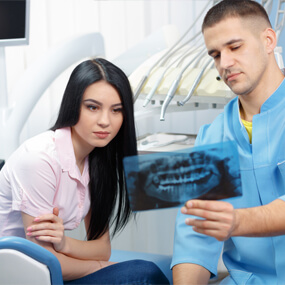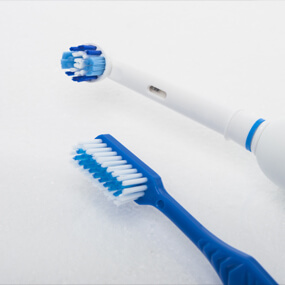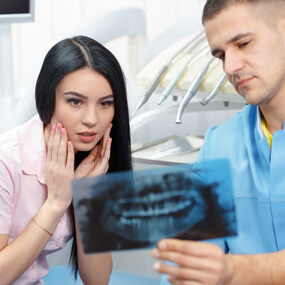Identifying and Overcoming Sleep Bruxism

Bruxism is a condition in which the jaw is excessively clenched or the teeth excessively ground down. Nocturnal bruxism—also known as sleep bruxism—is characterized by oral parafunctional activities that occur while a person is sleeping and thus unaware of the habit. Many affected people do not become aware until alerted by a bed partner or diagnosed by a dentist who has identified the dental damage.
There is a form of the condition that occurs during wakefulness—awake bruxism—but sleep bruxism is generally regarded as the more serious health concern. The unawareness can mean that a person grinds their teeth for years before the condition is diagnosed. Untreated like that, the teeth grinding can wear down the enamel and crowns of the teeth as well as any restorations. Teeth can loosen and even break, and headaches, jaw pain, and temporomandibular joint disorders are often symptoms too.
Sleep bruxism also inhibits your sleep and lowers the quality of your rest. The tensing of the muscles involved in teeth grinding and jaw clenching prevents the body from entering and maintaining a deep sleep. People who experience nocturnal bruxism often feel tired without recognizing the cause.
Bruxism Symptoms
Symptoms that indicate you may be experiencing sleep bruxism include:
- Facial pain
- Jaw pain and swelling
- Tooth pain and sensitivity
- Unexplained dental damage
- Unexplained daytime drowsiness
- Frequent headaches and earaches
If a bed partner informs you that gnashing or clenching were audible, then you should schedule an immediate appointment with your dentist. You should also see a dentist if you notice symptoms like those listed above and cannot attribute them to a known cause.
Is Bruxism Common?
The latest data suggests that 40 million Americans experience some degree of bruxism, and 10 percent of that group experiences the condition forcefully enough to damage teeth and oral restorations. Bruxism does tend to be more common in younger people. It is estimated that 13 percent of Americans under age 30 are affected, while only 3 percent of those over 60 experience it. Bruxism is most common in early childhood. In fact, the data suggests that a third of all young children grind their teeth, but this usually stops by around age 5 after the permanent teeth have emerged.
What Causes Bruxism?
What causes bruxism remains largely a mystery. Science has identified some notable risk factors, however. Bruxism can be a hereditary condition as well as brought on by stress. The condition is often a symptom of sleep disorders, such as obstructive sleep apnea (OSA), and sleep bruxism is more prevalent in people who regularly use tobacco, alcohol, and drugs.
Current research indicates that more than 70 percent of bruxism cases may be due to stress or anxiety. In adults, bruxism tends to be most common among people who are disposed to intense emotions as well as those who have hyperactive or aggressive personalities. This can manifest as a coping strategy, not unlike biting one’s nails, lips, cheeks, and so forth.
People with sleep-related breathing disorders like OSA certainly have a higher risk of nocturnal bruxism. The condition has also been found to be more common among people who talk in their sleep as well as those who have REM behavior disorders, which involve a person acting out their dreams. In addition to nicotine, alcohol, and psychoactive drugs, caffeine can exacerbate bruxism.
Sleep Bruxism in Children
As mentioned, sleep bruxism is very common in children prior to the emergence of their adult teeth. It is not uncommon for children to develop awake bruxism as a response to anxiety or as a coping mechanism for the pain that accompanies teething and earaches. In both cases, the bruxism is a lot like sleepwalking, night terrors, and bedwetting in that the vast majority of kids outgrow it. More than 50 percent of children who experience bruxism at some point outgrow it by age 13 and only about 5 percent of children carry the condition with them into adulthood.
Diagnosing Bruxism
Dentists are trained to identify the earliest signs of bruxism. If you have your teeth cleaned and examined every six months, then it is highly likely that you will be diagnosed very early on. There is no cure for bruxism. However, the symptoms are very manageable, and in many cases, there are therapies as well as lifestyle changes that can reduce or even eliminate the bruxism.
Treating Bruxism
Lifestyle modifications are often a focal point in order to reduce symptoms and improve the quality of sleep. There is often a focus on reducing stress levels as well as improving sleep hygiene. Sleep hygiene encompasses the habits and environment that make a good night’s sleep likely.
Good sleep hygiene often involves:
- Maintaining a regular bedtime and wake-up time
- Meditation and deep breathing exercises
- Baths, compresses, and massages to relieve tension
- Reducing caffeine, alcohol, and nicotine intake
- Avoiding caffeine and other stimulants right before bed
- Avoiding foods and snacks that may make the jaw muscles tense
In some cases, the lifestyle modifications are enough to alleviate the bruxism. In cases where lifestyle changes alone are not enough, your dentist will recommend a mouthguard. A bruxism night guard is an oral appliance that your dentist will custom-fit to your mouth. You wear the guard at night when you go to bed, and it forces your jaw into the proper position and keeps it there to avoid grinding.
To custom-mold the oral appliance, your dentist will make an impression of your teeth. This used to involve a dental putty and other messy, uncomfortable substances, but most dentists now have 3D imaging equipment and software that lets them create the mouthpiece right there on site.
In the event your sleep bruxism is due to OSA, your dentist may recommend a mandibular advancement device (MAD). Such a device is similar to a bruxism night guard in that it prevents tooth grinding. However, an MAD is different in that it is designed to keep the tongue forward and avoid it from blocking your airway.
Depending on the severity of your OSA, your sleep medicine specialist may recommend continuous positive airway pressure therapy. A CPAP machine involves wearing a mask at night. The machine blows air into your throat, which increases pressure in the airway and keeps it open. In this case, you likely will not need an oral appliance because this treatment will eliminate the related sleep bruxism.
Note that if your bruxism manifests as a symptom of an anxiety disorder, then treating that underlying issue can eliminate the bruxism and avoid the need for a mouthguard. Even in cases where the mouthguard must be worn, combining that use with cognitive behavioral therapy has proven to more effective than using a mouthguard alone. This emphasizes the link between bruxism and stress.
Stop Grinding Your Teeth
If you know that you grind your teeth or suspect it due to the symptoms you are experiencing, schedule an appointment with your dentist right away. Jeffrey D. Clark, DDS, is a leading dentist in Scottsdale and highly educated in the diagnosis of sleep bruxism and treating it through custom-fitted night guards. Schedule your exam with Dr. Clark today. Call Scottsdale Cosmetic Dentistry Excellence at 480 585 1853.




